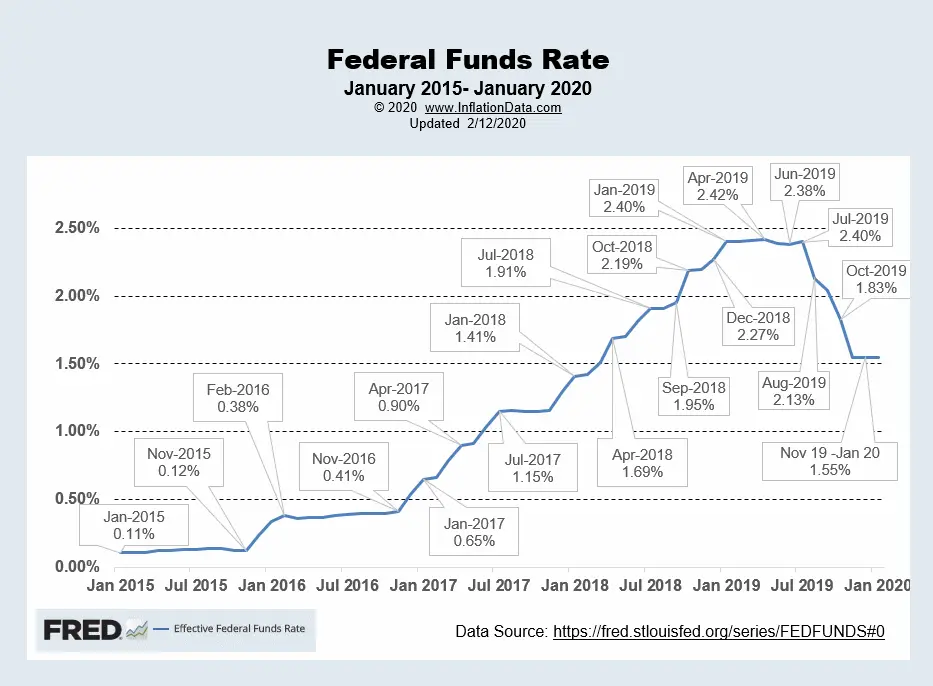By law banks are required to maintain a certain percentage of their assets in reserves at any given time. This money is held at the Federal Reserve bank and is called the “Reserve Requirement”. Generally, this money does not earn any interest. But, any money over and above this minimum can be loaned to other banks to who might not have enough reserves.
The rate that banks can charge each other is called the “Federal Funds rate” or “Fed Funds Rate”. The monetary policy-making body of the Federal Reserve System, is called the “Federal Open Market Committee” or “FOMC”. The FOMC meets eight times a year to discuss the economy and decide on any changes to monetary policy. One of the major policy factors that they discuss is where they will set the Fed Funds Rate.
Because the stock market hangs on every word that comes out of FOMC they carefully craft the wording of the report of their actions. They use the Fed Funds rate to tweak the economy. If they believe the economy is getting too sluggish they might lower the Fed Funds rate in an effort to stimulate borrowing which they hope will increase buying and therefore create more jobs and snowball into a healthier economy.
On the other hand, if the FOMC believes that the economy is getting “overheated” they might raise interest rates in an effort to dampen borrowing and buying, and thus reduce inflationary pressures.
Recently, Fed Funds rates began rising around January 2016 as the FED felt the economy was recovering and was able to sustain higher rates. They continued rising until January 2019 at which point the stock market was faltering so the FED halted any further raises. At their July 2019 meeting they announced that they would begin lowering the FED Funds rate which they did until November 2019 when they began holding steady at 1.55%.
Why Raising Interest Rates Might Dampen Inflation
When people expect things to cost more tomorrow than they do today (i.e. inflation) they tend to spend money faster rather than hold it or save it. After all, why hold onto something that will be worth less tomorrow than it is today. They may actually even borrow money they otherwise wouldn’t assuming that they can repay it with “cheaper dollars”. The speed that people want to spend their money is called “Velocity of Money”.
Raising interest rates makes that practice less profitable. It also raises the cost of buying a house, or borrowing to buy a car. Thus, fewer people can afford to buy things and this slows the economy down. Inflation and Velocity of money go hand in hand. The higher the inflation rate the faster people want to spend their money. But the faster they want to spend it the less likely they are to be “shopping around” looking for the best deal so venders can charge more which raises the inflation rate. By slowing the demand it also slows the velocity of money as well.
How the FED “Enforces” the FED Funds Rate
Technically, the Federal Reserve can’t enforce the FED Funds Rate. It is instead negotiated between the two banks, so the FED Funds Rate is simply a “target” range set by the FED. However, the FED also controls the “Discount Rate” which is the rate at which it will loan out money to individual banks. So, in effect it can set a cap on how much a bank has to pay.
Therefore, if the FED sets the FED Funds rate at 2% it might set the discount rate at 2.25%. That way no bank is going to pay another bank more than 2.25% if it can borrow directly from the FED for the discount rate.
The FED can also increase or decrease the money supply which will affect the reserves of both banks. Thus increasing the money supply will add reserves to both banks. This will decrease the first banks need to borrow and increase the 2nd banks desire to lend. Based on supply and demand factors this will have the effect of lowering the interest rate both banks are willing to trade at.
See Also:
- Does the FED control Mortgage Rates?
- Imports, Exports, and Exchange Rates
- How the Economy Works
- Inflation: The Hidden Tax
- How the FED Controls the Money Supply



Leave a Reply